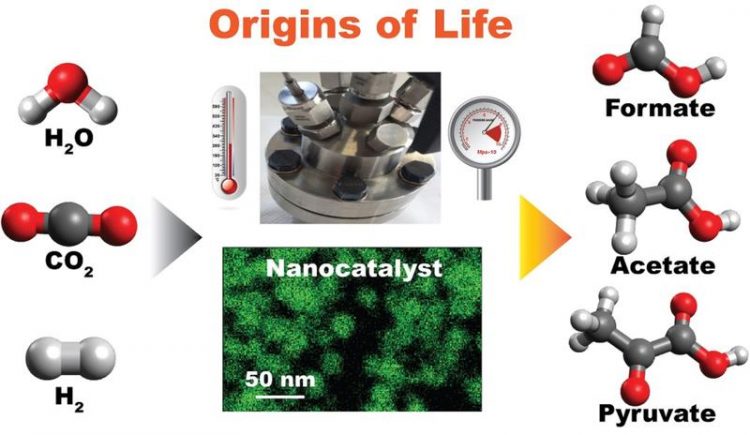New findings on how life could have originated on Earth – hydrogen as a fuel and carbon dioxide as building block

CO2- transformation in earliest biochemical processes PD Dr. Harun Tüysüz, MPI für Kohlenforschung
An international research team from Germany (PD Dr. Harun Tüysüz and Prof. Dr. William Martin), France (Prof. Dr. Joseph Moran) and Japan (Prof. Dr. Yoichi Kamagata) has published exciting new research results on the origins of life in the journal Nature Ecology and Evolution.
The research focuses on chemical processes that occur at submarine hydrothermal vents and are necessary for the formation and metabolism of the most primitive life forms.
The research team, to which also belongs PD Dr. Harun Tüysüz from the Max-Planck-Institut für Kohlenforschung, was able to prove that – in the presence of carbon dioxide as a building block – hydrogen was the fuel for the earliest biochemical processes at the beginning of life.
In laboratory experiments, evolutionary researchers under the direction of the HHU Düsseldorf simulated the reactions that took place at deep-sea vents and probably led to the first free-living cells.
The vents eject hot, mineral-rich water containing hydrogen and carbon dioxide, which in a metal-catalyzed reaction provides energy for the metabolism of the simplest forms of life.
Just as microbes can exploit carbon dioxide and hydrogen gas, convert it into acetates, formic acid and pyruvates and use it to form all their organic material, the reaction can be simulated in the lab using suitable catalysts. The scientists showed that hydrogen H2 and carbon dioxide CO2 can be converted into acetates, pyruvates and formate overnight at 100 °C using simple mineral catalysts.
The decisive factors were suitable nanostructured solid catalysts designed by Harun Tüysüz's team. “The special structure of our catalysts has had a decisive influence on the reactivity and has driven it forward,” the researcher says.
The research results now published allow us to draw conclusions about how life could start. Initially, there were simple chemical reactions that were catalyzed by metals and minerals. More complex nucleic acids and proteins developed from these products, in which relics of the biochemical origins can still be found today.
In addition, the reactions between the hydrogen and carbon dioxide formed – even today – in the deep sea release energy that may have driven the metabolism of the primordial cells. Hydrogen is therefore not only a clean energy source of the future, but can – under the right conditions and in the presence of the right catalysts – also have been central to the origins of life.
The study now published was funded by the European Research Council, the Volkswagen Foundation, the German Research Foundation, the Max Planck Society, the Japanese Society for the Promotion of Science and the Japanese Ministry of Education, Culture, Sports, Science and Technology
Max-Planck-Institut für Kohlenforschung
PD Dr. Harun Tüysüz, Leader of the Group of Heterogeneous Catalysis and Sustainable Energy
Phone: 0208/306-2371
Link to the publication: DOI: 10.1038/s41559-020-1125-6
Media Contact
More Information:
https://www.kofo.mpg.deAll latest news from the category: Life Sciences and Chemistry
Articles and reports from the Life Sciences and chemistry area deal with applied and basic research into modern biology, chemistry and human medicine.
Valuable information can be found on a range of life sciences fields including bacteriology, biochemistry, bionics, bioinformatics, biophysics, biotechnology, genetics, geobotany, human biology, marine biology, microbiology, molecular biology, cellular biology, zoology, bioinorganic chemistry, microchemistry and environmental chemistry.
Newest articles

NASA: Mystery of life’s handedness deepens
The mystery of why life uses molecules with specific orientations has deepened with a NASA-funded discovery that RNA — a key molecule thought to have potentially held the instructions for…

What are the effects of historic lithium mining on water quality?
Study reveals low levels of common contaminants but high levels of other elements in waters associated with an abandoned lithium mine. Lithium ore and mining waste from a historic lithium…

Quantum-inspired design boosts efficiency of heat-to-electricity conversion
Rice engineers take unconventional route to improving thermophotovoltaic systems. Researchers at Rice University have found a new way to improve a key element of thermophotovoltaic (TPV) systems, which convert heat…



